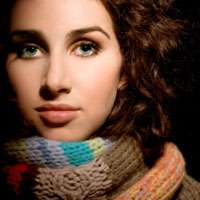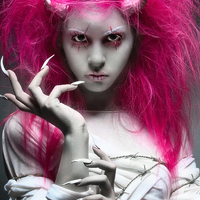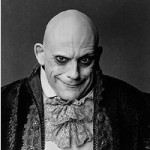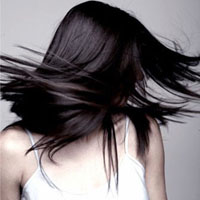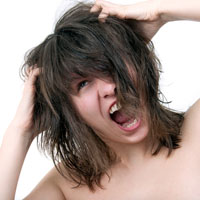
Have you ever experienced an itchy scalp, burning sensation or rash immediately after dying your hair? If so, it could be that you have an allergy to a particular type of hair dye.
Approximately 50 million women in the US dye their hair every year but how many of us really know what goes into our hair dye and how it can affect our health?
Different forms of hair dye can contain bleaches, ammonias and other chemicals that can have detrimental effects on your hair including dry locks, frizziness and lack of body. And don’t forget when you dye your hair that these elements can affect your scalp too.
Unless you advised by a professional that a pre-dye test isn’t needed (for example some salons use vegetable based hair dyes which don’t produce allergic reactions), you should always do a tint test beforehand to check for any allergic reactions.
The tint test
Home dye kits and salons should include instructions on how to do a ‘tint test’ whereby a small amount of dye is placed on the inside of the wrist, the eye of the elbow or behind the ear. You will be familiar with this practice if you get your eyebrows or lashes dyed regularly.
The dye is left to dry and remains on the skin without washing for 24-48 hours. During that time you should record any changes that occur in your skin.
Types of allergic reaction
If you have a reaction to the dye you may notice itching, pinkness or a rash around the area it was applied or you may experience a hot tingling sensation. In the worse cases more serious side effects can include incessant itching or irritation causing dermatitis on the site of the dye, a rash spreading across the rest of the body and, very rarely, anaphylaxis (shortness of breath, swelling and an inability to breathe).
What do I do if I have a reaction?
If you do a tint test and notice any side effects, wash off the dye immediately with a mild soap and warm water. For more severe reactions, wash off the dye as above then seek medical help from your doctor or call for an ambulance.
Any reaction during the tint test is a sure sign that if you put it on your hair your scalp will react in the same way, potentially producing an uncomfortable and embarrassing affliction and in the most extreme cases can result in hospitalization if you are hyper sensitive to the ingredients.
What causes allergies to hair color?
Ingredients in hair dyes differ from product to product but there are some common chemicals to look out for:
Ammonia and Hydrogen Peroxide (bleach) are commonly found in hair dyes used to permanently lighten hair and create blonde locks. You can often smell this ingredient even if you’re unaware of its inclusion in the dye.
Reactions to hydrogen peroxide are two-fold as if left on too long, it can dry out and burn the skin, leaving a nasty red reaction. Inhalation of hydrogen peroxide can also cause a reaction causing shortness of breath in those sensitive to the ingredient.
PPD (Paraphenylenediamine) is a chemical widely used in hair dyes that contain darker colors and black dye. This chemical is often found in home dye kits that contain two bottles – the dye in one and the developer in the other.
PPD is usually found in the dye bottle and if applied to the skin alone can cause severe reactions. The likelihood of an allergic reaction from this is unlikely when it is combined with the developer (however this is often ammonia – see above).
Other chemicals with lesser reactions include Para-aminodiphenylamine (PADA) and paratoluene diamine (PTDA) and 3-nitro-p-hydroxyethylaminophenol. If you are aware of either skin allergies or sensitivities to hair dyes then your safest bet is to avoid all hair dyes containing any of these ingredients to avoid reaction completely.
Is it true that henna hair color can cause allergic reactions?
Henna is a natural hair dye that has been widely used for thousands of years, and is largely seen as a organic and safe alternative to using chemical hair color products. The plant is a protein that adheres to the hair and following application it takes a long time for the color to develop, therefore any sensitivity to the dye should be tested before it is applied.
Now here comes the confusing part; although henna is widely regarded as a safe option for those wishing to avoid chemical allergies, it should not be mistaken for its namesake that is a lot more dangerous; black henna.
Black henna is a dangerous mix of chemicals and it’s use as a hair color product is largely legislated against in the United States. It’s name derives from the late 19th century when plant-based hair colors where imported into the west, and consequently mixed with chemicals to make cosmetic products.
It is very important that black henna is not confused with it’s organic namesake.
Black henna can cause severe allergic reactions as it contains PPD. Black henna tattoos (the dye is often used for tattoos and body art as well as a hair colorant) should be avoided whilst coloring your hair as this can result in hospitalization due to overexposure of PPD.
What are the Alternatives?
If you suffer from sensitive skin and know that a regular hair dye is out of the question you can try some of the following natural products which are suitable for those with allergies.
Lush – offer a selection of vegan Henna hair colors, which are made using natural henna, which does not contain PPD but instead is made from henna leaf and conditioning cocoa butter. Available in four dark auburn shades.
Daniel Field – offers organic and mineral home hair colorants. These are suitable for both vegetarians and vegans. They do contain PPD but no ammonia or hydrogen peroxide and are water based. These come in a variety of colors for blondes, brunettes and redheads.
Palette by Nature – have a wide selection of permanent hair colors which are PPD free. They don’t contain harsh chemicals and instead actually offer botanical products with ingredients to soothe and calm the skin. All the products are plant based, are 50% organic and approved by the American Contact Dermatitis Society (ACDS), named as ‘one of the safest alternatives to conventional hair color for chemically sensitive people’.
